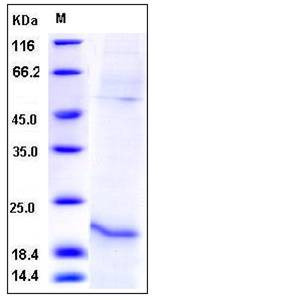Human Relaxin-1 / RLN1 Protein (His Tag)
bA12D24.3.1,bA12D24.3.2,H1,H1RLX,RLN1,RLXH1
- 100ug (NPP4215) Please inquiry
| Catalog Number | P11625-H08H |
|---|---|
| Organism Species | Human |
| Host | Human Cells |
| Synonyms | bA12D24.3.1,bA12D24.3.2,H1,H1RLX,RLN1,RLXH1 |
| Molecular Weight | The secreted pro form of recombinant human RLN1 consists of 174 amino acids and predictes a molecular mass of 20 kDa as estimated in SDS-PAGE under reducing conditions. |
| predicted N | Val 23 |
| SDS-PAGE |  |
| Purity | > 82 % as determined by SDS-PAGE |
| Protein Construction | A DNA sequence encoding the human RLN1 (NP_008842.1) (Met 1-Cys 185) was fused with a polyhistidine tag at the C-terminus. |
| Bio-activity | |
| Research Area | |
| Formulation | Lyophilized from sterile PBS, pH 7.4 1. Normally 5 % - 8 % trehalose and mannitol are added as protectants before lyophilization. Specific concentrations are included in the hardcopy of COA. |
| Background | Relaxin-1, also known as Prorelaxin H1 and RLN1, is a secreted protein which belongs to the insulin family. It is a peptide hormone that was first described in 1926 by Frederick Hisaw. Since its discovery as a reproductive hormone 80 years ago, relaxin has been implicated in a number of pregnancy-related functions involving extracellular matrix (ECM) turnover and collagen degradation. It is now becoming evident that relaxin's ability to reduce matrix synthesis and increase ECM degradation has important implications in several nonreproductive organs, including the heart, lung, kidney, liver and skin. The relaxin-like peptide family belongs in the insulin superfamily and consists of 7 peptides of high structural but low sequence similarity; relaxin-1 (RNL1), relaxin-2 (RNL2) and relaxin-3 ( RNL3), and the insulin-like (INSL) peptides, INSL3, INSL4, INSL5 and INSL6. The functions of relaxin-3, INSL4, INSL5, INSL6 remain uncharacterised. Relaxin-1 / RLN1 is an ovarian hormone that acts with estrogen to produce dilatation of the birth canal in many mammals. Relaxin-1 / RLN1 may be involved in remodeling of connective tissues during pregnancy, promoting growth of pubic ligaments and ripening of the cervix. Relaxin and estrogen appear to play protective roles against airway fibrosis, airway SM thickening, and cardiac hypertrophy. Relaxin may also provide a means to regulate excessive collagen deposition during kidney development and in diseased states characterized by renal fibrosis. |
| Reference |
